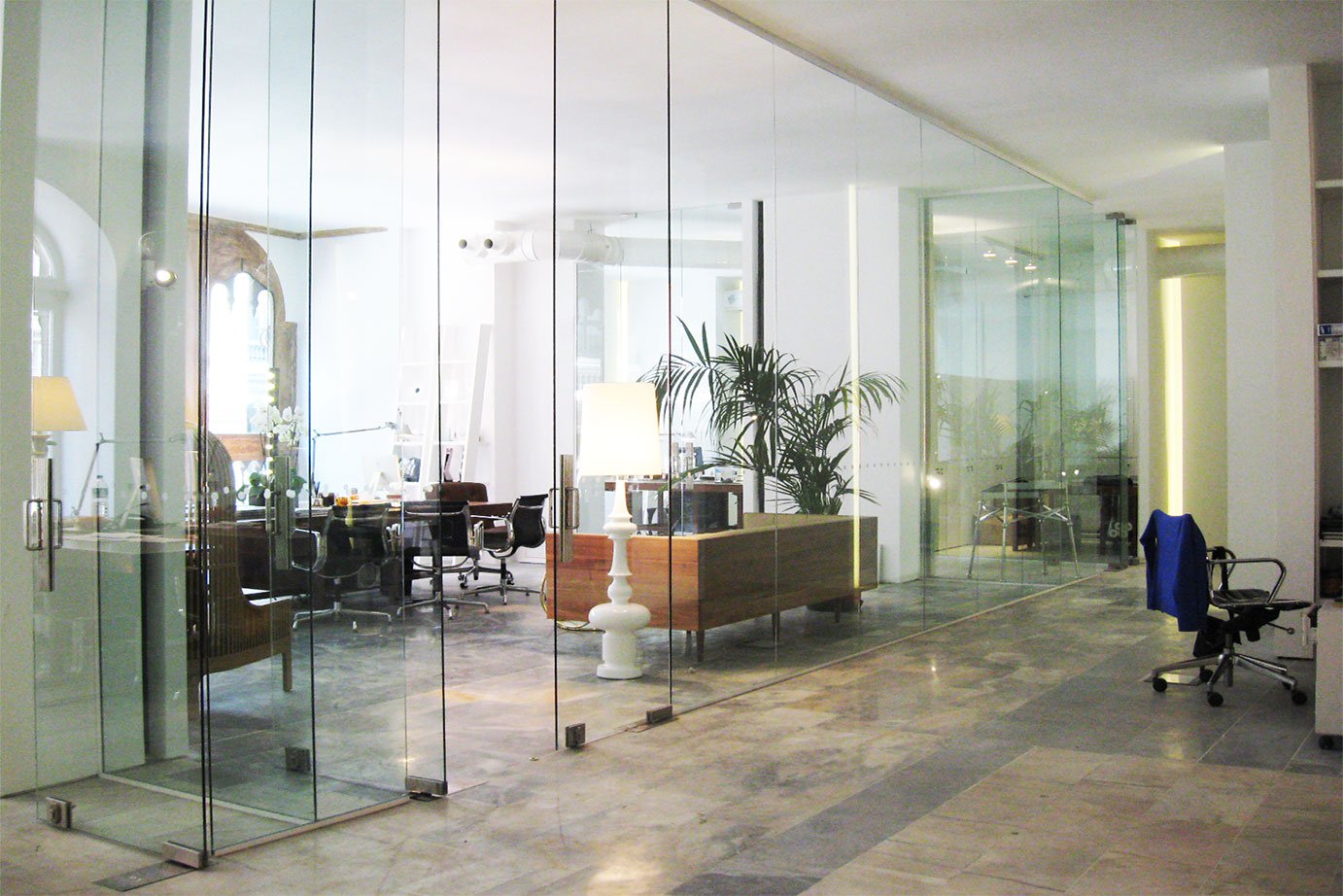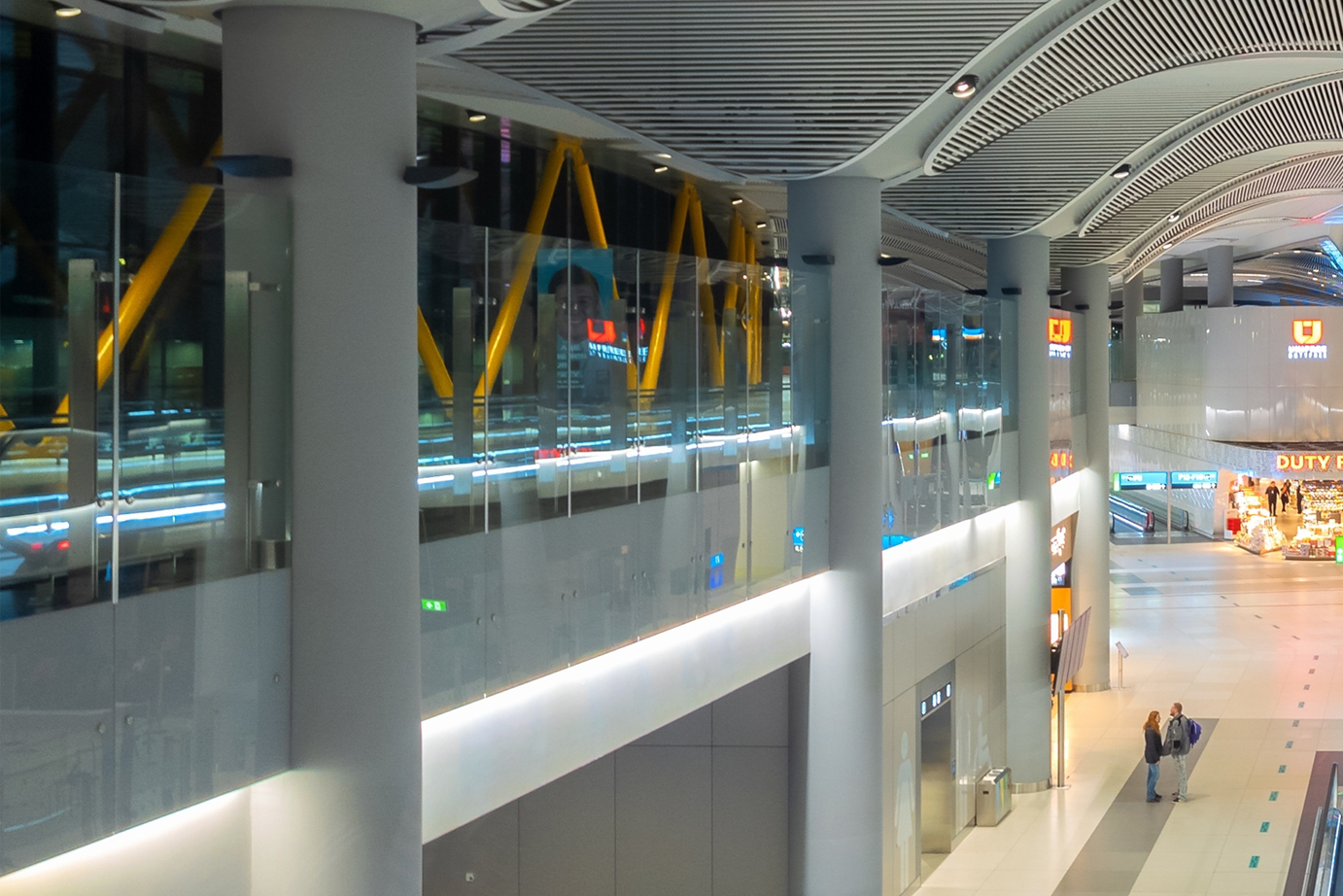Tempering is the heat treatment of the glass. Tempering is done by heating the glass at 650 – 700°C in a furnace for a sufficient period of time and followed by sudden cooling by compressed air. The surface hardens with reduced temperature. Firstly, the outer surface, then the inner part of the glass cools down, so that on surfaces compressive stress accumulates, while the center has tensile stress. Tempered glasses are approximately 5 times more durable than regular glass. Heat resistance is more than normal glass. It is a Safety Glass class product that does not cause injury to the users due to the small size of the fragments when it’s broken.
Processes such as cutting, edge processing and drilling cannot be performed on tempered glasses. Tempering process does not change the volume, color and chemical structure of the glass.
While the tempered glass can withstand a sudden temperature change of 200 °C (thermal shock), the non-tempered glass can be broken when subjected to thermal shock of about 40 °C.
Tempered glass is used where the glass is expected hardly to break but when its broken should not harm the users. Such as; facade windows, white goods glasses (oven - refrigerator etc.), automotive industry (vehicle side and rear windows), shower and bathtub glass, furniture glass (coffee table - table - cupboard, etc.), railing, handrail, balcony closing systems glass, lighting fixture glass, etc.
| Thicknesses | 6 - 8 - 10 - 12 - 15 - 19 mm |
| Dimensions | 2800 x 5000 Minimum:150 x 350 |
| 4 mm Dimensions | Max.: 2850 x 2200 mm / Min.: 150 x 350 mm |
| 5 mm Dimensions | Max.: 2850 x 4800 mm / Min.: 150 x 350 mm |
Camglass is the biggest Turkish Tempered Glass Manufacturer
In the tempering process, the glass is first heated to about 650 degrees and then cooled suddenly by blowing air.
Oven settings change depending on the thickness, color, and/or coating type of the glass.
Due to the tension differences created on the surface and body of the glass as a result of heating and sudden cooling.
The glass becomes 4-5 times more resistant to impacts.
When broken, it breaks into small pieces like a membrane that has no cutting feature.
Its resistance to thermal stresses increases.
Because of these features, tempered glass is also called safety glass.
Before tempering, edge processing is applied to the glass. Cut glass cannot be tempered.
Tempered glass cannot be cut, holes cannot be drilled.
Tempering can be done as "full temper" or "partial temper".
Tempered glass can be the end product or used as a semi-finished product in laminated glass or double glazing.
Tempering is one of the most critical processes in the factory. About 70-75% of the cut glass is tempered.
Temper is the Heat Treatment Process of Glass.
By tempering the glass, we strengthen it (5 layers) and break it into pieces that will not harm when broken.
Temperable glasses:
- Flat glass – Low iron glass
- Tinted glass
- reflective glass
- Low-e / Solar Low-e
- Frosted glass
- Decorative glass (Acid etching)
- Anti-Reflective Glass
- Painted Glass (T)
Non-temperable glasses:
- Mirror
- Laminated Glass
- Painted Glass
- Stranded Glass
- Soft Low-e (Comfort/Synergy)
- Matobel
Tempered Glass Turkey

WHAT IS TEMPER?
Basically; It is to heat the glass sufficiently in an oven and quickly cool it.
1- Heat the glass well above 570 C (transition temperature)
2- While heating the glass, keep it flat in the oven.
3- Shape the glass if desired (Bombing process)
4- Cool it quickly so that the lower and upper surface temperatures of the glass are equal.
5- Keep cooling until the glass drops to ambient temperature
Tempered glass, which is a safety glass, has the feature of breaking the glass shards into small pieces in a way that does not cause injury as a result of possible breakage.
The tempering process not only gives the glass a safety feature but also increases its mechanical strength of the glass.
The tempering process is also done to increase the resistance of the glass against thermal stresses. The resistance of tempered glass to sudden temperature change is 200°C.
Non-tempered glass, on the other hand, can withstand a sudden temperature change of up to 40°C.
tempered glasses; Glazing from the floor to a height of 80 cm from the finished floor level, all the joinery that continues uninterruptedly from the finished floor level to the ceiling, glass doors and joinery integrated to these doors, in motor vehicles, on the facades of buildings, in creating a winter garden by closing the gardens with glass, closing balconies, dividing workplaces with glass They are used in stair-step construction, elevator windows, curved industrial refrigerators, white goods, etc.
In general, no other treatment is applied to tempered glass. After tempering; Glass explodes when cutting, drilling, countersinking, edge, and surface grinding operations are performed.
Grinding or band grinding should be applied to the edges of the glasses to be tempered. The reason for grinding the edges of the glass or cleaning the burrs on the edge of the hole by countersinking is to eliminate the risk of breakage during tempering by eliminating the capillary cracks and glass sharpness that occur during cutting.
The grinding process is the process of giving a profile to the sharp edges of the glass with a diamond stone. Even if this sharpness is removed with a diamond band, the edge of the glass does not gain a profile. Having holes in the glass can cause problems during heating. Since the inner edges of the holes absorb the heat, they expand more than the surrounding glass mass. If there is a hole close to the edge, tensile stress will occur between them, and if there are small cracks on the edge of the hole, it will cause the glass to break. Therefore, burr-free edges of the holes, if possible countersunk, will reduce possible breakage during tempering.
Tempered Glass Production
The glass, which has been cut to size and processed with edge processing, is heated up to 620 -630 °C upon forming temperature. In the heating process, heat transfer occurs in three different ways.
1) Transmission (conduct); energy transmission by the contact of the lower surface of the glass with the ceramic rollers of the furnace.
2) Convection (convection); Energy transmission by the contact of the air mass circulating inside the furnace on both surfaces of the glass.
This can happen in two ways; a) By supporting the heating with compressed air aspirators in a standard oven b) By moving the air mass by air circulation fans in a convection oven
3) Electromagnetic radiation (radiation); is the dissipation of heat from the surface of the glass to the inside of the glass by electromagnetic radiation.
The glass, which is heated equally everywhere, is taken to the cooling (Quench) section (there should not be much heat loss during this transition). In Quench, the glass is rapidly cooled by blowing pressurized ambient air from the top and bottom.
Meanwhile, the glass rapidly loses heat first from its lower and upper surfaces, and then from its center. This process should be such that the upper and lower surface temperatures of the glass are equal by controlling the cooling rate.
The glass is then cooled to ambient temperature.
PARTIAL TEMPERED GLASS
Although it is not safety glass, partially tempered glass, which is a glass widely used in the production of insulating glass, is produced in a tempering furnace. Glass made of cutting, drilling, countersinking, edge and surface grinding, etc. processes is heated to above the forming temperature, then in the cooling zone (quench) with lower blowing pressure (20% of normal blowing pressure) than normal tempered glass. up) is rapidly cooled.
Partially tempered glass means glass with lower tensile stress. It is located between float glass and tempered glass in terms of its properties. Due to the slower cooling process during production, there is no risk of sudden breakage due to nickel sulfide in partially tempered glass. It is about 2 times more resistant to breakage and heat than normal glass.
The refractive image is similar to that of float glass.
THERMAL BATHING (HEAT SOAKING)
During the production of float glass, nickel sulfide particles of approximately 100 – 200 microns in size, enter the glass during the use of the tempered glass, expanding with the heating of the glass, causing the tempered glass to explode.
To eliminate such a risk, the Thermal Bath Test (Heat soaking) is carried out according to the TS EN 14179 standard. Heat soaking is done if the customer requests it.
After the glass is tempered, it is taken into a furnace for heat soaking. Tempered glasses are kept here for 2 hours with the surface temperature of the glass in the range of 2 6 0 0 C ± 10 0 C. During this firing, if there is a nickel sulfide particle in the tempered glass, it will break. If the glass is tested intact, either there is no Nickel sulfide particle in the glass or it is in such a small diameter that it poses no risk and does not pose a risk for the glass to break. Although this test minimizes the risk of breakage, it does not provide a complete guarantee. Studies have shown that although it has passed the test, it is due to nickel sulfide where the glass is installed. It has shown that it can be broken with a probability of 1 in 10,000.
TEMPER QUALITY
According to TS EN 12150-1
NUMBER OF PARTICLES
2 and 3 mm thickness min. 15 pieces
4 – 12 mm thickness min. 40 pieces
15 – 19 mm thickness min. 30 units
HUMPBACK – General
1-meter max. 3mm
ROLLER WAVE
Max. 0.3mm
CORNER LIFT
3mm thickness max 0.5mm
4 and 5 mm thickness max 0.4mm
6 – 19 mm thickness max 0.3mm
ANISOTROPY
In the tempered glass, they are the images of air traces that are formed due to the distribution of internal stress and cannot be prevented. These voltages produce the birefringent effect that can be seen in polarized light, appearing as dark circles or lines depending on the viewing angle. It is more noticeable with polarized glasses.
In the tempering standard, these marks were defined as leopard spots, and it was stated that there were no errors.

 EN
EN 

